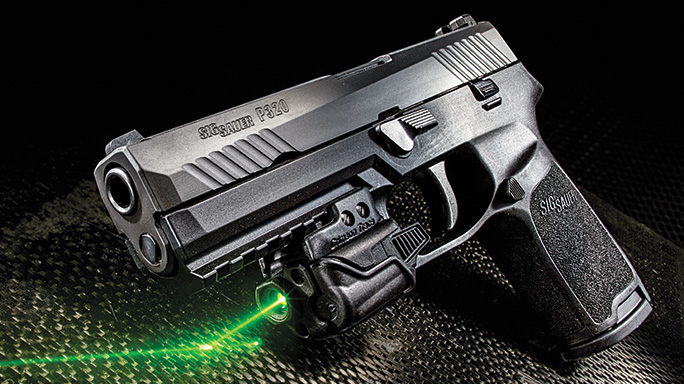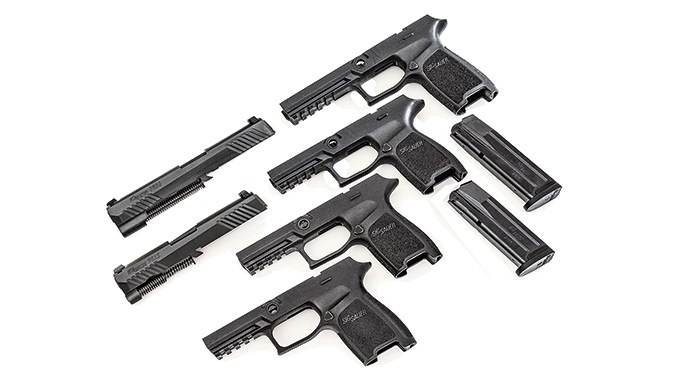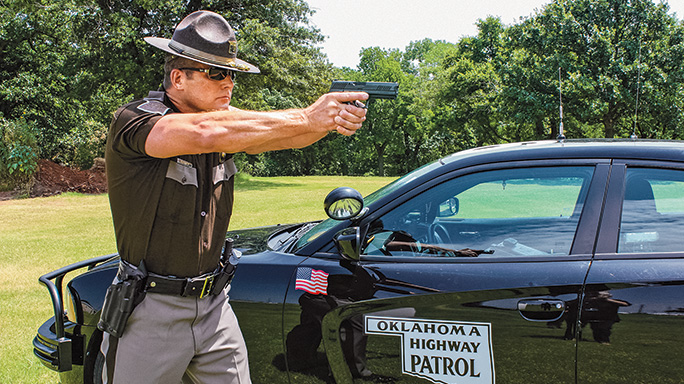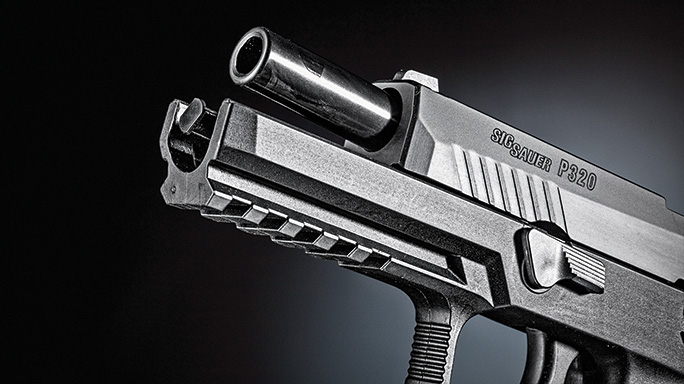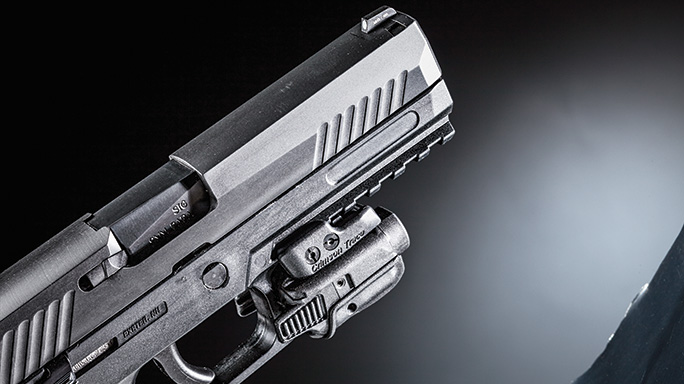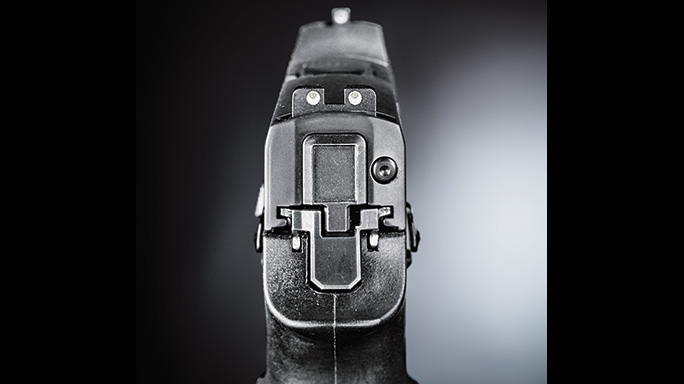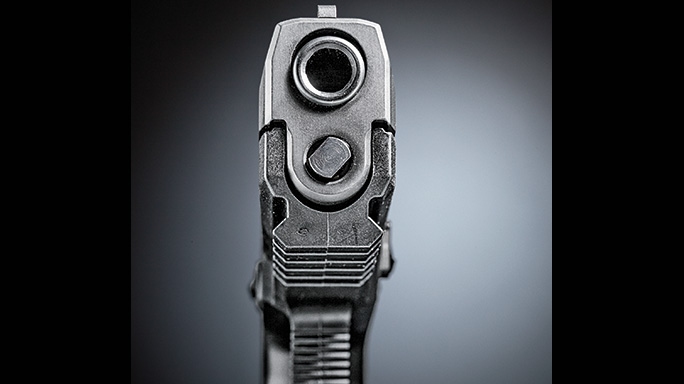Over the years, I have avoided using superlatives like “game-changer,” “revolutionary” and “groundbreaking” in terms of new firearms. But I must admit that the Sig Sauer P320 deserves each of these titles. In fact, the P320 has even changed the definition of what part of the pistol is the pistol.
- RELATED STORY: Gun Test: Sig Sauer’s Legion Series of Pistols
The P320 is the most advanced modular pistol on the market today, and the Oklahoma Highway Patrol (OHP) recently adopted it, making the OHP the first large agency to do so. But first, let’s learn a little bit more about this innovative weapon system.
Mod Machine
Advertisement — Continue Reading Below
The P320 is considered a polymer-framed pistol, but the polymer frame is more of a housing. Instead, the pistol—the controlled (serial numbered) part—is the internal chassis. The stainless steel chassis houses the fire control system, slide stop and frame rails fore and aft. A window is cut into the right side of the polymer frame to allow the chassis’ serial number to be viewed. What would normally be called the frame is now called the grip module. In describing the P320, the word “modular” is frequently used, and that’s because its design allows the user to switch between four different frame sizes and three different slide lengths.
There are currently four P320 variants with accompanying slides and frames: Full Size, Carry, Compact and Subcompact. The height of the Full Size is similar to a Smith & Wesson M&P while the Carry and Compact are close to the height of a Glock 19. The Compact is 0.2 inches shorter in height than the Carry. The Subcompact is slightly taller than a Glock 26 within the same class. In addition to the difference in height, the grip modules are available in small, medium and large circumferences to accommodate different hand sizes.
Sig offers three slide/barrel units for the P320. The Full Size features a 4.7-inch barrel while the Carry and Compact slides feature a 3.9-inch barrel. The Subcompact slide sports a 3.6-inch barrel. Along with size options, the system allows for caliber conversions as well. All of the P320 sizes can be converted between 9mm, .40 S&W, .357 SIG and .45 ACP.
Advertisement — Continue Reading Below
The P320 also offers several enhanced safety features that make it unique in its field. The internal striker safety prevents the striker from being released until the trigger is pulled. A disconnect safety prevents the pistol from firing if the slide is out of battery. Finally, the Three-Point Takedown Safety System requires that the magazine be removed and the slide locked to the rear before the takedown lever can be rotated to the proper position. Sig Sauer is quick to note that the P320 does not require the trigger to be pulled before the pistol can be field-stripped. Recognizing the needs of the law enforcement, Sig offers the options of a trigger safety toggle and a magazine disconnect safety (for law enforcement only).
On top of all of this, Sig’s engineers have worked hard to make the P320 as ergonomically friendly as possible. In addition to the four different frame modules, all P320 models feature an ambidextrous slide stop and a reversible -magazine catch. Textured panels are neatly imprinted on the frontstrap, backstrap and sides of the grip. The frame also features a high-cut frontstrap and finger reliefs on each side of the grip. The grip angle is set at 103 degrees to mirror the pointability characteristics of the 1911. As with other Sig Sauer pistols, the triggerguard provides generous clearance for large hands or use when wearing gloves.
Personal Testing
Advertisement — Continue Reading Below
We received a P320 Full Size in 9mm for our evaluation—the same model adopted by the Oklahoma Highway Patrol. Having read the preliminary reports on the pistol, I had high expectations for it, and I was not disappointed. My test sample pistol arrived in a hard plastic case along with a polymer holster, two magazines and the obligatory safety lock. To my surprise, Sig Sauer included a very detailed, 67-page instruction manual and a flyer for Mil-Com’s TW25B synthetic grease.
The SIGLITE tritium three-dot night sights were low profile but easily indexed. The leading edge of the rear sight provides an adequate point of contact for one-handed slide manipulations. The trigger on our test gun is best described as having a smooth, short roll without a hard wall and with very limited overtravel. The trigger pull averaged a clean 8 pounds.
On the range, the P320 gobbled up everything we found to feed it. We broke in the P320 using Aguila 124-grain FMJ rounds. For those who have not kept up with Aguila, the company is now under new management, with Texas Armament and Technology being the sole importer for the U.S. market. This ammo is newly manufactured from quality components and is great for training. In addition, we shot three duty loads that ranged from HPR’s super-light 85-grain BlackOps OTF to Sig’s hotter 124-grain V-Crown JHPs. The 4.7-inch barrel, combined with the grip-to-bore angle, made the P320 extremely controllable.
Advertisement — Continue Reading Below
When we got down to testing the duty ammo, we found that the HPR load produced a velocity of 1,338 fps while the PNW 115-grain, solid-copper round averaged 1,105 fps. Both were extremely soft-shooting loads. Sig’s 124-grain JHP, while not rated as +P load, produced an average velocity of 1,134 fps. The extreme velocity spreads were all within acceptable ranges, with the PNW load having a spread of only 19 fps.
Sig Sauer pistols are known for their accuracy, and the P320 was no exception. I had an amazing group going with the HPR Black Ops load until I threw the last round. The first four rounds produced a single ragged hole that measured 0.36 inches. Unfortunately, the last round opened the group up to 2.13 inches. The PNW load produced a group that measured 1.26 inches, while the Sig Sauer load measured 1.30 inches.
OK Enforcers REPORT
Advertisement — Continue Reading Below
To get the OHP’s take on the P320, I contacted Lieutenant Todd Fenimore, who is responsible for the agency’s firearms and defensive tactics program as well as its 80 instructors. Fenimore explained that his agency has a long history with Sig Sauer and has issued Sig pistols since 1993. Prior to the adoption of the P320, the issued service pistol was the P226 in .357 SIG. As with other agencies, the OHP made the decision to transition to a polymer-framed, striker-fired pistol. Following the current trend, the department also made the decision to switch to the 9mm. After extensive testing, the agency selected Hornady’s 135-grain +P Critical Duty ammo as its issued load. This was due in part to this load’s penetration characteristics, and the fact that the great majority of the agency’s shootings are in and around vehicles.
One issue did come up during the evaluation program. As with other similar pistols, shooters who fire with a thumbs-forward grip had a tendency to impede the slide stop, preventing the slide from locking back after firing the last round. When Fenimore relayed this issue to Sig Sauer, the company offered to equip the OHP guns with a reduced-profile slide stop to correct the issue. In addition, Sig Sauer has redesigned the grip frame to include a new molded shelf to push the thumb away from the slide lock. In other words, this is a company that really listens to its customers.
Fenimore relayed that a recent class of recruits was issued the first batch of P320s. During the first day of orientation, their groups were so tight that the instructors decided to have the students shoot a qualification course. Out of 21 recruits, 20 passed the course with an average score of 86. This was directly attributed to the P320’s trigger, caliber and handling characteristics. As a result, the class was able to transition to more dynamic drills and tactical training earlier than normal.
Advertisement — Continue Reading Below
The Oklahoma Highway Patrol is staffed by 807 commissioned troopers that cover 77 counties and 69,900 square miles. New recruits are required to complete a 20-week, boot-camp-like academy. Each recruit qualifies with the service pistol, shotgun and rifle. Recruits are issued the P320 and a light-capable Safariland ALS duty holster. Troopers are also permitted to use pistol-mounted lights. In the past, the agency has had a very liberal firearms policy that allowed a variety of manufacturers, models and calibers. Currently, troopers are allowed to carry pistols in 9mm, .40S&W, .357 SIG and .45 ACP. Thankfully, the modularity of the P320 makes it an easier and more economical choice.
- RELATED VIDEO: MCX: Sig Sauer’s Incredibly Modular Carbine
The Sig Sauer P320 has a lot to offer both law enforcement officers and armed citizens. It’s easy and affordable to switch between chamberings and various slide/frame configurations. This also allows an agency to purchase one pistol that can be configured for multiple assignments. The P320 is a trendsetter in a crowded marketplace, and with multiple federal agencies looking for a new service pistol, Sig Sauer has a lot to offer.
For more information, visit sigsauer.com or call 603-610-3000.
Advertisement — Continue Reading Below
Specifications
- CALIBER: 9mm
- BARREL: 4.7 inches
- OA LENGTH: 8 inches
- WEIGHT: 29.4 ounces (empty)
- GRIP: Polymer
- SIGHTS: SIGLITE night
- ACTION: Striker-fired
- FINISH: Nitron
- CAPACITY: 17+1
- MSRP: $679
